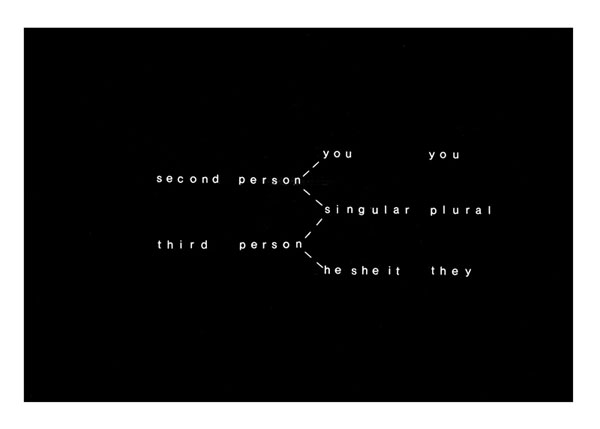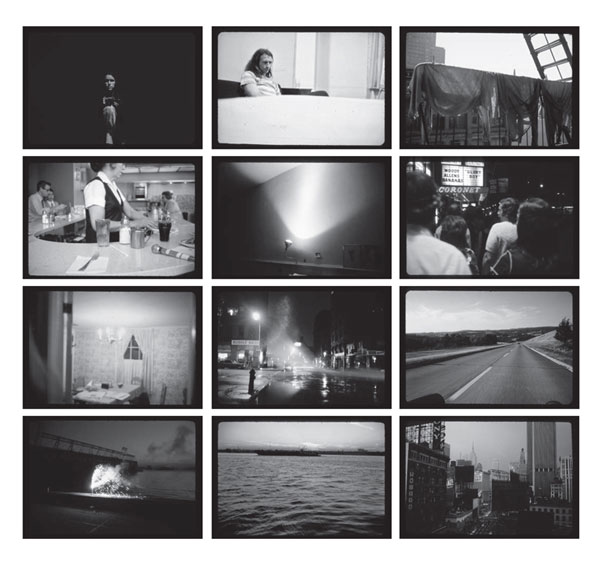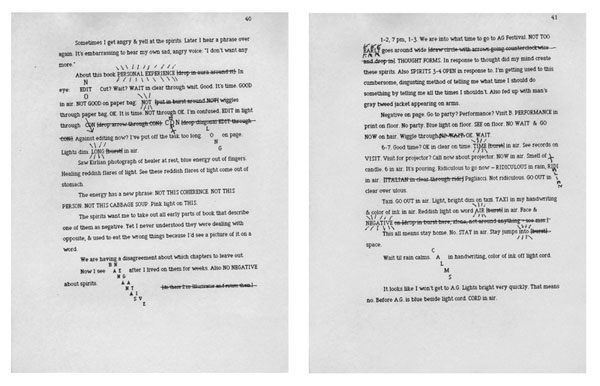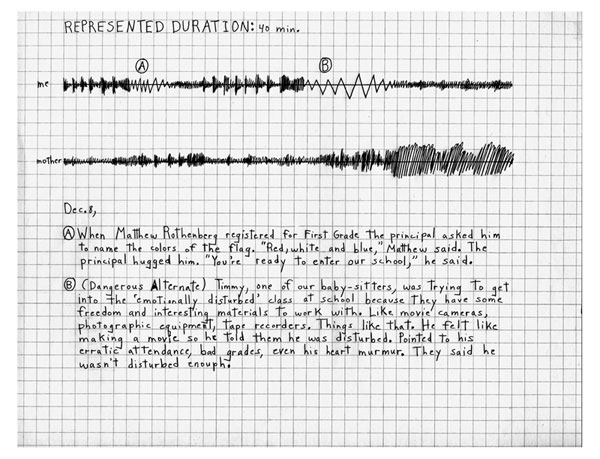In Gray There is Multiplicity
Snapshots from It Is Almost That / A Collection of Image+Text work by Women Artists & Writers
BY Eileen Myles

In gray there is multiplicity. It’s the last line of this book. Lisa Pearson, who edited It Is Almost That, tells us a million things before we get to this stunning line. And when I read it (and underlined it with my Sharpie), I thought, “That’s the beginning of the book” (which it was for me, because I turned it around and began reading it differently).
What I liked so much about this ending (and the explanation that immediately preceded it) is that I was tactically allowed, as a reader, to have my own experience of this book, and was told here rather than up-front exactly what went into the assembling of this creation—which is a collection of 26 image+text pieces by a slightly larger number of female artists. Some of the pieces here are collaborations, and one is in fact by a group. It’s a lot of territory, and in Lisa Pearson we’ve got an adept and unobtrusive tour guide.
And guide us, she did do.
She told us how she decided which pieces not to include, and how she made exceptions. Her considerations included thoughts about color (the requirement for included pieces is for each of them to work in black-and-white—or grayscale, ideally) and the relative fame or obscurity of the artist—and their individual piece mattered, too. The elegantly jumbled end result is the reward for this quirky decision process. As readers, we’re both massaged and piqued by what we do and don’t sometimes already know, and often we are glad to see a piece in a fresh context (Bernadette Mayer’s Memory, for example). But the collection also delivers a wallop through its surprises.
There’s an odd early piece by Louise Bourgeois. As drawing and text and meditation, it’s a compelling inclusion, but the real payoff for me was experiencing Louise Bourgeois as a girl. I don’t mean the word diminutively. I mean she was young once, and we are so used to the career of Louise Bourgeois being a grand old one. We also learn (maybe everyone knows this) that at the age of 71 her career went “international,” which is inspiring. There’s such an abundance of small turns, informed views, and ledges on this reading trip. Its organization makes the point that a book that gathers female art doesn’t need to be explained away as feminist. It’s something else. Just tell us about female lives and female art careers all in one place, and it’s more like we’re having tea with Pema Chödrön. The inspiration (and the desolation) of the female artist is vibrantly there. Because the frame is image+text, we’re reminded that all of us generally do more. Female artists don’t just stay in their disciplines; we experience, we forage, we play.
Intuitively and practically speaking, This Is Almost That is, in effect, a handbook. It, by presenting female art history, shows us how to be an artist. Each career here, whether its arc is short or long, presents a new kind of way. Because the format is strong and uniform. Title, artist, date, and artist statement. Bios at the back of the book. When the work presented didn’t hold my attention, the tiny quote from the artist at the front sometimes did. And since almost a quarter of the artists included are deceased, they weren’t filling in their bio and statement form. The information was culled from journals and public statements and letters. And I think the reason the book has a consciousness-raising effect is because it’s not intentional. It’s adamantly an aesthetic selection, with relationships between the contributions being prime rather anyone being positioned as this or that. Finally, we are reminded that “images are not illustrative and language does not explain.” It’s gray and it’s vague. For readers and wanderers. So hooray. Let’s go.
•
Adrian Piper’s Political Self-Portraits come first, which are very well known in the art world, but alongside other writing her narratives sit differently. “I’ve had the Gray Experience” is how Piper exhaustively sums up her own mixed-race, mixed-class childhood in Harlem and exclusive Manhattan prep schools. And her stories (with grayscale pictures from her childhood superimposed over the texts) could have been monologues by Spalding Gray. One of the revelations here is how much artists in the ’70s and ’80s in different genres were laying themselves bare toward a single end, I think, which was to establish a wide sense of interconnection with each other and their audiences and communities rather than simply with their own corner of the art world. Yet the confines of our institutions did limit the reach of any message. We weren’t all on computers yet—not that they would have brought us even closer. Rereading Piper’s portraits now feels extremely rewarding and timely—when our president is of mixed race, yet to get elected he could not really divulge his early memories—certainly not as exquisitely and remorselessly as Adrian Piper did, so her piece is a gift from her time to ours. It’s a cultural inside we need to see—in order to understand our condition as a people.
•
Ketty La Rocca follows Adrian Piper. Her name has a vaguely familiar ring. She was an Italian performance artist from Florence who died at 37—of a “brain disease.” Her piece in this book is a sequence of photographs of signaling hands: handgrips and -shakes, which are themselves signaling opportunity, revealing gender, location, action. I couldn’t help thinking about how deeply these gestures are linked to the feminist work and bodywork of her time (including dance), but also I found myself thinking about scouting. Which is the earliest bonding clubs that kids are in. How a sequence of gestures like these cemented one’s entrance into the club. With their apparent confidences and closures, I saw secrecy. I saw a woman standing outside watching the world, and then claiming it. These top-lit hands sent me flying to the Internet to see what else the artist had done and if her early death was the reason why I didn’t know her. I learned that she moved from photographs to video, using sound, and particularly the human voice, with special attention to the repetition of the word “you.” But the hand “remains the symbolic performer of all her works, the instrument to express the unsatisfied need [. . .] for a love extending indefinitely through time.”
•

The book title It Is Almost That is also the title of a piece from 1977 by Theresa Hak Kyung Cha. In the book it appears as the first of a series of black maquettes for slide projection. “It is almost that” is written in tiny white Helvetica letters and the slides that follow are thinking about narration (click-click, click-click), alone and in groups, and the piece ends with the word “plural.” Theresa Cha was killed on a Friday night in the lobby of the Puck Building in New York City when she walked in to wait for her husband. The Puck Building. Before it was redone. When it was this large funky monstrosity on Lafayette and Houston where artists had studios and occasional concerts and events happened. Two doorways of the building are still adorned with the golden figures of a weird baby with a top hat and curls who is standing outside looking down on all of our fleeting lives.
•

Bernadette Mayer’s Memory should be (and is) included here. The poem and photographs here are excerpted from that longer work. Memory is a hymn to a specific moment in ’70s New York—the one Bernadette was living in. The long, open-lined poem of its title is as much a photograph of itself as the photographs are, since the lines do what poet James Schuyler said of his own work: point and snap. The work itself was excerpted at the University of Maine a few years back as a multimedia installation, the color photos themselves appearing and vanishing as Bernadette’s soft, deep voice uttered the outlines of her thoughts about a world made of light and temporality. The piece is infused with sadness for reasons that only its author knows. And I do experience loss as the thread that links so many of these pieces. To one another. That binds their own parts to themselves.
•

In Pictures and Early Words (1972), Hannah Weiner practically starved waiting for the voices that increasingly controlled her life. They let her know what and when and where she could eat. Images and words for her didn’t so much appear on the page as in the world. The phone would say no. She was thinking of having a turkey club, but she was warned by a voice emanating from the phone against moving toward it. In fact, the only instructions she was given were about what she couldn’t eat. Her life increasingly became a moving feint between negative spaces, doing finally not so much what she wanted but what was possible. The condition she lived in reads somewhat like a feminist allegory. How can she stop listening to the voices that will not allow her to live? But can she live alone without them? What would she be then in silence? Finally Hannah ate at a café on East Third Street and Avenue A, a diner where I once had breakfast and decided, based on my state of mind and all that was going on around me, that I would eat there every single day for the rest of my life, and now I don’t know how long it’s been gone. When did it vanish? Hannah Weiner had been involved in AIM (the American Indian Movement) at an earlier moment in her life, before the episodes that her writing here enacts. No images accompany these written pieces, though what we do have is a photostat of the original typescript pages, which were unconventional in their layout and full of uppercase commands. What I am trying to say is that Hannah, through both her politics and her history in the avant-garde, was open to vision in its most radical sense, even as it took over her mind. She was open to the implications of the politics of that space, even though she was very hungry.
•

I once saw an Eleanor Antin piece in the WACK show at the Museum of Contemporary Art in Los Angeles that notated on graph paper the frequency of her baby’s crying while artist and baby were visiting, I believe, the same parents who are being visited in Domestic Peace (1971–72), the piece in this book. Here there is handwriting on the graph paper, suggesting appropriate topics for a young mother (and artist) who is in town to kill two birds with one stone, fulfilling both art and family obligations in a single trip to New York. Family is the bird plotted along these vertical and horizontal lines of the graph paper (which is actually blue, Lisa Pearson explains, and she suggests we can imagine color particularly easily in this project). Thanks to the formalism of Antin’s piece, the color comes through easily and thanks to her humor.
•

Alison Knowles may have written the first computerized poem. Represented in their entirety are these incantations of her opus A House of Dust, variously proposing:
A HOUSE OF DUST
IN AN OVERPOPULATED AREA
USING ALL AVAILABLE LIGHTING
INHABITED BY VEGETARIANS
or:
A HOUSE OF PAPER
IN A DESERTED FACTORY
USING ALL AVAILABLE LIGHTING
INHABITED BY ALL RACES OF MEN REPRESENTED
WEARING PREDOMINANTLY RED CLOTHING
She produced several hundred of these on computer sheets as the result of four different lists fed to a computer. In another rendition the stanzas were separated and photographed, each with “gifts”—drawings, computer cards, tools, erasers, and seashells. Stanza and gift were photographed together and exhibited, and later the poems and their subjects were turned into postcards, so a horse might be walking across a computer-generated landscape, forever one day. When I think of Allison Knowles, I always picture her grinning. Her kind of conceptual art seemed to only make her happy, though I’m sure she had a human life like yours or mine. In her artist’s statement, she reminds us:
It is important to remember that we are free to make art and poetry out of anything: a loaf of bread, some beans, a hasty jotting on the train.
•
Unica Zürn was among the Paris Surrealists of the 1950s, and she became associated romantically with the artist Hans Bellmer—over whom she wound up throwing herself out the window of his studio over—then dying, in 1970. Her piece The House of Illnesses is based on one of the many trips she made to the hospital for physical and mental health issues. In it she gives both written accounts and ornate illustrations of the days of the week in the hospital, accompanied by tiny legends that read like this:
- Sunday, Monday
- I spent a sunny morning in the thumbnail. It was a quiet but festive sojourn
- Door
- . . . and these are the chambers of the hands
And she shows them! Her writing reminds me of Robert Walser: dainty, crooked, facetiously brilliant. One entry called “Various Observations” shares a fanciful contempt for the body and even femaleness, which is a running theme of this book, but which is treated most piquantly and acerbically here. I love Unica. She’s such an angry, articulate woman. Since Lisa Pearson says that this book is the first in a series of “similar” books, I think a collection of work by, say, women horrified by motherhood, or even work by lesbians, none of whom turn up here, would be another worthy direction. Unica writes:
The situation is much the same with the bosom room here. Milk gushes out from the crack under the locked door, and the white, sickly smell wafts through the keyhole and turns my stomach.
•
The final entry of the book is Charlotte Salomon’s Life? Or Theater? A Song Play, which is a “monumental” visual novel of hundreds of gouaches produced during 1940–42 that tells the story of three generations of a Jewish family during the Weimar Republic and the rise of the Nazis. Her work reminds me of Nicole Eisenman’s in its fluidity, its brashly unerring confidence and skill. It tells the story of a young woman befuddled by a world full of men. She is knocking heads continually with male authority, and the work bursts with the problems of being a budding female artist and the necessity of learning how to not staunch the overflowing riches of her own echoey brain. Charlotte’s drawings hold up the sky here. Her position at the end of the book is an emotional placement, but a telling one too, in that both writing and visual art are present in this work yet only the art truly gets to speak. There’s text but the voice of it feels more like gestures than any kind of speech. Silence proves to be the strongest thoroughfare through this wonderful guidebook for girls. Men should buy it to give to someone but keep it for themselves.
So many women live so much of their lives in this other language. Is this fact known? The hands are indeed the major organ. Hands are the truest organ of exchange. The morning in my life I knew I had grown up was when I woke up from a dream and sat in bed looking at mine. What will I do. My hands tell me all that I know. Charlotte Salomon died in 1943 in Auschwitz because she was a Jew, and also because she got married to a man who was Jewish as well, and because of that act they were caught. They fled Vichy France, then came back and were quickly deported. Charlotte died three days after she arrived in the camp. There’s something I feel that’s so beyond my ken when I look at these drawings by such a lushly talented woman in her 20s, who was making work so redolent of the same concerns as my contemporary friends. I find myself looking again at these drawings to confirm that they are not reproduced in color. I remember their browns, their reds, and their grays. More than art is represented here. It seems I know her life.
It is almost that.
Eileen Myles was born in Cambridge, Massachusetts, and was educated at the University of Massachusetts-Boston. They moved to New York City in 1974 to be a poet, and subsequently a novelist, art journalist, and writer of libretti. They gravitated to the St. Mark’s Poetry Project, where they studied with Ted Berrigan, Alice Notley, Paul Violi, and Bill Zavatsky. From 1984 to 1986, Myles was the artistic...


